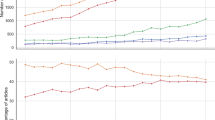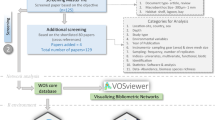Abstract
This paper evaluates the importance of jointly conducted research versus national, when neighbouring countries are trying to study a topic of their mutual interest. The chosen topic was the shared ocean or lake basin. The number of non-mutual and mutual articles in the period 1999–2008 for seven pairs of neighbouring countries was analysed by extracting published articles and citations from the Web of Science database. It was found that mutual articles have generally better visibility than the non-mutual articles, valid even for large and developed countries. Also, the percentage of self-citations in the mutual articles is much lower than in the non-mutual ones. However, the citations of the non-mutual articles are influenced by the development of the country or, in some cases, by the development of the countries in which researchers from a certain country are presently working (this applies strongly to the Eastern Europe countries).




Similar content being viewed by others
References
Beaver, D. D. (2001). Reflections on scientific collaboration, (and its study): Past, present, and future. Scientometrics, 52, 365–377.
Beaver, D. D. (2004). Does collaborative research have greater epistemic authority? Scientometrics, 60, 399–408.
Bouabib, H., & Martin, B. R. (2009). Evaluation of Moroccan research using a bibliometric-based approach: Investigation of the validity of the h-index. Scientometrics, 78, 203–217.
De Fillipo, D., Morillo, F., & Fernandez, M. T. (2008). Indicators of scientific collaboration between CSIC and Latin America through international databases. Revista Española de Documentación Científica, 33(1), 66–84.
Feigel’man, M. (2007). Save Russian science. Nature Physics, 3, 138–139.
Ferner, R. E., & Aronson, J. K. (2005). National differences in publishing papers on adverse drug reactions. British Journal of Clinical Pharmacology, 59, 108–111.
Glänzel, W. (2001). National characteristics in international scientific co-authorship relations. Scientometrics, 51, 69–115.
Glänzel, W., Schubert, A., & Czerwon, H.-J. (1999). A bibliometric analysis of international scientific cooperation of the European Union (1985–1995). Scientometrics, 45, 185–202.
Katsouyanni, K. (2008). Collaborative research: Accomplishments & potential. Environmental Health, 7, 3. doi:10.1186/1476-069X-7-3.
Klaić, Z. B., & Klaić, B. (2004). Croatian scientific publications in top journals according to the Science Citation Index for the 1980–2000 period. Scientometrics, 61, 221–251.
Leta, J., & Chaimovich, H. (2002). Recognition and international collaboration: The Brasilian case. Scientometrics, 53, 325–335.
Olmeda-Gómez, C., Perianes-Rodriguez, A., Ovalle-Perandones, A., Guerrero-Bote, V. P., & Anegón, F. D. (2009). Visualization of scientific co-authorship in Spanish universities. Aslib Proceedings: New Information Perspectives, 61(1), 83–100.
Prpić, K. (2007). Changes of scientific knowledge production and research productivity in a transitional society. Scientometrics, 72, 487–511.
Russel, J. M. (1998). Publishing patterns of Mexican scientists: Differences between national and international papers. Scientometrics, 41, 113–124.
Schubert, A., & Schubert, M. (2009). Outperform your neighbours. Scientometrics, 80, 555–560.
Snyder, H., & Bonzi, S. (1998). Patterns of self-citation across disciplines (1980–1989). Journal of Information Science, 24, 432–435.
Sooryamoorthy, R. (2009). Do types of collaboration change citation? Collaboration and citation patterns of South African science publications, Scientometrics. doi: 10.1007/s11192-009-2126-z.
Vinkler, P. (2008). Correlation between the structure of scientific research, scientometric indicators and GDP in EU and non-EU countries. Scientometrics, 74, 237–254.
Acknowledgements
The support for this research is given by the Ministry of Science, Education and Sports of the Republic of Croatia (grant 001-0013077-1122).
Author information
Authors and Affiliations
Corresponding author
Rights and permissions
About this article
Cite this article
Vilibić, I. How much the shared ocean or lake basins connect the researchers in neighbouring countries?. Scientometrics 83, 463–470 (2010). https://doi.org/10.1007/s11192-009-0010-5
Received:
Accepted:
Published:
Issue Date:
DOI: https://doi.org/10.1007/s11192-009-0010-5




